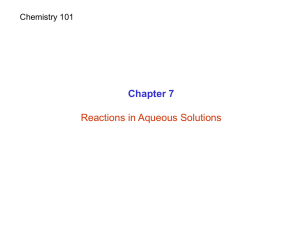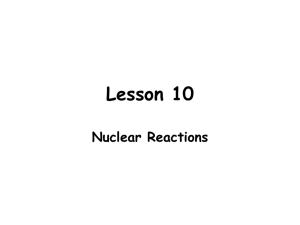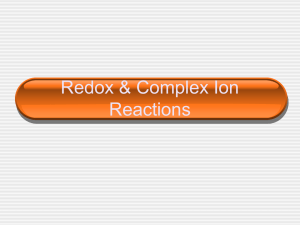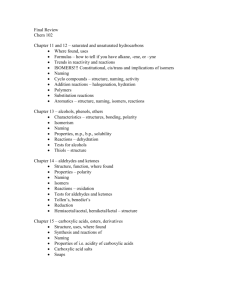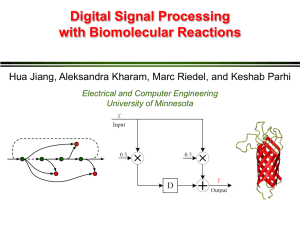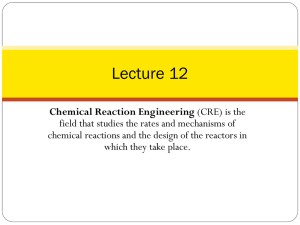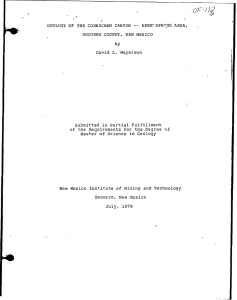Chapter 7 - Bakersfield College
advertisement
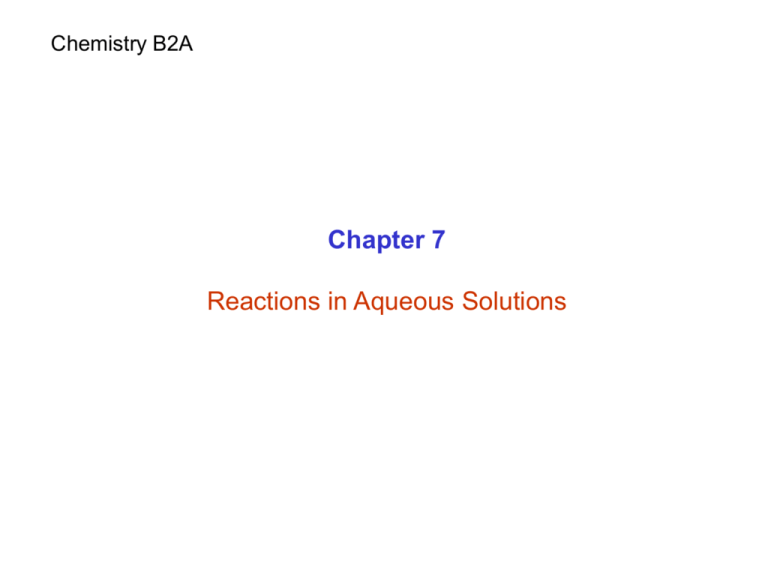
Chemistry B2A Chapter 7 Reactions in Aqueous Solutions Reactions in Aqueous Solutions Ionic compounds Aqueous solution: solvent is water Reactions in Aqueous Solutions Chemical reactions that occur in water. In our body reactions occur in the aqueous solution. Water in our body 1. About 60% of our body. 2. Most of the reactions occur in aqueous solution. 3. Participates in many biochemical reactions. 4. Transports reactants and products from one place in our body to another. 5. Eliminates the waste materials from cells and our body (urine). Why does a chemical reaction occur? Several driving forces: 1. Formation of a solid 2. Formation of water 3. Transfer of electrons 4. Formation of a gas Why does a chemical reaction occur? Several driving forces: 1. Formation of a solid 2. Formation of water 3. Transfer of electrons 4. Formation of a gas Formation of a solid Precipitation reactions Precipitate KI + Pb(NO3)2 ? Ionic Compounds When an ionic compound dissolves in water, ions are produced. Ions Hydrated by H2O Hydration Ionic Compounds 1. Soluble solid: it completely dissolves in water (ions are formed). 2. Slightly soluble solid: it partially dissolves in water. 3. Insoluble solid: it does not dissociate in water (almost). Ionic compounds = Salts Ionic Compounds All nitrates (NO3-) and acetate (CH3COO-) are soluble in water. Most salts of Na+, K+, and NH4+ are soluble in water. Most chlorides (Cl-) and sulfates (SO42-) are soluble in water. (except AgCl, PbCl2, BaSO4, CaSO4, PbSO4) Most carbonates (CO32-), phosphates (PO43-), Sulfide (S2-), and hydroxides (OH-) are insoluble in water. (except NaOH, KOH, Ba(OH)2, Ca(OH)2, and NH4OH) Electrolytes bulb Electrolyte: conducts an electric current. Na+ Clelectrolyte + - Ionization (Dissociation) NaCl → Na+ + Cl- strong electrolytes: molecules dissociate completely into ions (NaCl). weak electrolytes: molecules dissociate partially into ions (CH3COOH). nonelectrolytes: molecules do not dissociate into ions (DI water). Formation of a solid Precipitation reactions Precipitate KI + Pb(NO3)2 ? Aqueous Solution (ionic compounds) aqueous solution: solvent is water KI(s) H2O K+(aq) + I-(aq) Dissociation (Ionization) KI K+ Pb(NO3)2(s) H2O Pb2+(aq) + 2NO3-(aq) I- Pb(NO3)2 Pb2+ NO3NO3- Aqueous Solution KI (ionic compounds) Pb(NO3)2 K+ I- Pb2+ NO3- 2KI(aq) + Pb(NO3)2(aq) PbI2(s) + 2KNO3(aq) Molecular equation: 2KI(aq) + Pb(NO3)2(aq) PbI2(s) + 2KNO3(aq) Complete Ionic equation: 2K+(aq) + Pb2+(aq) + 2I-(aq) + 2NO3-(aq) PbI2(s) + 2K+(aq) + 2NO3-(aq) 2K+(aq) + Pb2+(aq) + 2I-(aq) + 2NO3-(aq) PbI2(s) + 2K+(aq) + 2NO3-(aq) Spectator ions Net ionic equation: Pb2+(aq) + 2I-(aq) PbI2(s) total charge on left side = total charge on right side balanced equation 2As3+(aq) + 3s2-(aq) As2S3(s) Why does a chemical reaction occur? Several driving forces: 1. Formation of a solid 2. Formation of water 3. Transfer of electrons 4. Formation of a gas Acids and Bases Acids: sour Bases: bitter or salty Acids and Bases Arrhenius definition: Acid: produces H3O+ (H+) in water. CH3COOH(aq) + H2O(l) CH3COO-(aq) + H3O+(aq) H3O+ (Hydronium ion): H+(aq) + H2O(l) H3O+(aq) Base: produces OH- in water. NaOH(s) H2O NH3(aq) + H2O(l) Na+(aq) + OH-(aq) NH4+(aq) + OH-(aq) Acids and Bases Weak acid and base: it is partially ionized in aqueous solution. produces less H+ and OH- CH3COOH(aq) + H2O(l) NH3(aq) + H2O(l) CH3COO-(aq) + H3O+(aq) NH4+(aq) + OH-(aq) Strong acid and base: it is completely ionized in aqueous solution. produces more H+ and OH- HCl(aq) + H2O(l) Cl-(aq) + H3O+(aq) NaOH(aq) + H2O(l) Na+(aq) + OH-(aq) Acid-Base Reactions Neutralization A strong acid and a strong base react together to produce a salt and water. NaOH(aq) + HCl(aq) NaCl(aq) + H2O(l) Na+(aq) + OH-(aq) + H+(aq) + Cl-(aq) + Na+(aq) + Cl-(aq) + H2O(l) H+(aq) + OH-(aq) H2O(l) The only chemical change is the formation of water. Why does a chemical reaction occur? Several driving forces: 1. Formation of a solid 2. Formation of water 3. Transfer of electrons 4. Formation of a gas Oxidation and Reduction reactions (redox) e- 2Na(s) + Cl2(g) 2NaCl(s) Na → Na+ + eCl + e- → Cl- Metal + Nonmetal : Transfer of electrons Oxidation and Reduction reactions (redox) Oxidation and Reduction reactions (redox) oxidation: it is the loss of electrons. reduction: it is the gain of electrons. Zn(s) + Cu2+(aq) Zn2+(aq) + Cu(s) redox reaction Zn(s) Zn2+(aq) + 2e- Zn is oxidized (reducing agent) Cu2+(aq) + 2e- Cu(s) Cu2+ is reduced (oxidizing agent) Oxidation and Reduction reactions (redox) oxidation: is the gain of oxygen / loss of hydrogen. reduction: is the loss of oxygen / gain of hydrogen. CH4(s) + 2O2(g) CO2(g) + 2H2O(g) C gains O and loses H is oxidized O gains H Is reduced (reducing agent) (oxidizing agent) redox reaction single replacement reaction and combustion reactions redox reactions double replacement reactions non redox Classification of chemical reactions Chemical reactions Precipitation Reactions Combustions Reactions Oxidation-Reduction Reactions Acid-Base Reactions Synthesis (combination) Reactions Decomposition (Analysis) Reactions (Reactants are elements.) (Products are elements.)
